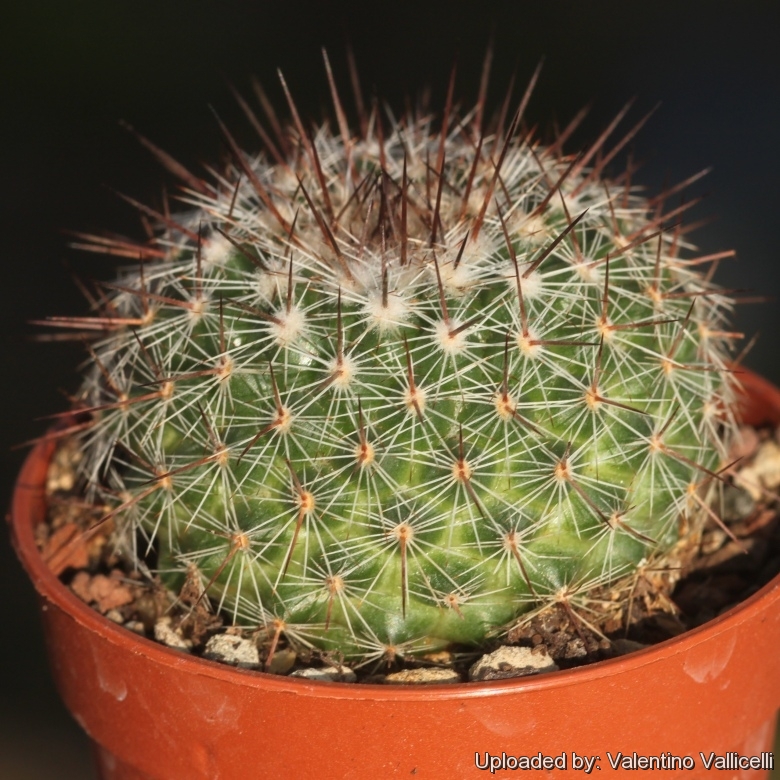= Mammillaria lindsayi var. cobrensis Repp.
Gattung Mammill. Monogr. 2: 667 (1992), without latin descr. or type. et: Mitteilungsbl. AfM 17(1): 21, 26–30 (1993) Repp.
Accepted Scientific Name: Mammillaria standleyi (Britton & Rose) Orcutt
Cactography 8. 1926 [ cf: Gentry - Publ. Carnegie Inst. Wash. No. 527 (Rio Mayo Pl.) 196 (1942). ] Orcutt

Mammillaria sinforosensis subs. cobrensis (Mammillaria lindsayi var. cobrensis) Photo by: Valentino Vallicelli
Origin and Habitat: Barranca del Cobre, Chihuahua, Mexico
Altitude: 2200-2300 metres above sea level.
Synonyms:
See all synonyms of Mammillaria standleyi
back
Accepted name in llifle Database:Mammillaria standleyi (Britton & Rose) OrcuttCactography 8. 1926 [ cf: Gentry - Publ. Carnegie Inst. Wash. No. 527 (Rio Mayo Pl.) 196 (1942). ]Synonymy: 24
back
Description: Mammillaria lindsayiSN|20796]]SN|20796]] var. cobrensis is a local or morphological form of Mammillaria lindsayiSN|20796]]SN|20796]] distinguishable from the type for the stem that is always solitary with a very woolly apex. The stem is dark green and lacks of bristles in the woolly tubercles axil.
Stem: Symmetrically globose, dark-green, depressed, with apex that appears completely covered by dense white wool, 12-15 cm high and in diameter. With latex.
Tubercles: Conical to quadrangular, keeled, arranged in numerous, close-set spirals. (Parastichy number 13-21) with dense white axillary wool and up to 8 white, without twisted bristles.
Areoles: Oval and with white wool when young.
Radial spines: 10-14, white with tan to golden yellow bases, 2 - 8 mm long, upper ones shortest.
Central spines: 2-4, straight, acicular/subulated, rigid, divergent, golden brown, reddish to almost black, the 2-3 uppermost short (approx 4 mm long) long, The lowermost longest 4-12 mm long (or more).
Flowers: Small, funnelform, 15-20 mm long, to 10 mm in diameter, light greenish yellow with orange-yellow midveins. Stamens above the nectar-chamber.
Fruits: Club shaped to cylindrical, attractively deep coloured dull pinkish-red to scarlet, up to 20 mm long and 2-3 mm wide.
Seeds: Brown.
More...Subspecies, varieties, forms and cultivars of plants belonging to the Mammillaria standleyi group
 Mammillaria floresii Fritz Schwarz: usually solitary. Central spines (2-)4, reddish 5-9 mm long. Radials few to 16, 4-8 mm long. Flowers purplish red to 12 mm long. Distribution: San Bernardo, Sonora.
Mammillaria floresii Fritz Schwarz: usually solitary. Central spines (2-)4, reddish 5-9 mm long. Radials few to 16, 4-8 mm long. Flowers purplish red to 12 mm long. Distribution: San Bernardo, Sonora. Mammillaria lindsayi R.T.Craig: forms clumps up to 1 m wide, has white axillary wool and bristles. Radial spines 10-14 white, centrals 2-4 , straight, brown to black, flowers greenish yellow. Distribution: Chihuahua and Sinaloa, Mexico.
Mammillaria lindsayi R.T.Craig: forms clumps up to 1 m wide, has white axillary wool and bristles. Radial spines 10-14 white, centrals 2-4 , straight, brown to black, flowers greenish yellow. Distribution: Chihuahua and Sinaloa, Mexico. Mammillaria lindsayi var. cobrensis Repp.: is distinguishable from the type for the stem that is always solitary with a very woolly apex. The stem is dark green and it lacks of bristles in the woolly tubercles axil. Distribution: Barranca del Cobre, Chihuahua, Mexico.
Mammillaria lindsayi var. cobrensis Repp.: is distinguishable from the type for the stem that is always solitary with a very woolly apex. The stem is dark green and it lacks of bristles in the woolly tubercles axil. Distribution: Barranca del Cobre, Chihuahua, Mexico.- Mammillaria lindsayi var. rubriflora Hils: as the name implies it has reddish flower.
 Mammillaria miegiana W.H.Earle: mostly solitary with stems, densely covered by spines appearing white and producing large, dark reddish-pink flowers with scarlet midveins. Distribution: Northem Sonora.
Mammillaria miegiana W.H.Earle: mostly solitary with stems, densely covered by spines appearing white and producing large, dark reddish-pink flowers with scarlet midveins. Distribution: Northem Sonora. Mammillaria standleyi (Britton & Rose) Orcutt: very variable, with white radial spine, brownish centrals and white wool between the tubercles. Flowers purplish up to 12 mm long. Distribution: Chihuahua, Sinaloa, and Sonora.
Mammillaria standleyi (Britton & Rose) Orcutt: very variable, with white radial spine, brownish centrals and white wool between the tubercles. Flowers purplish up to 12 mm long. Distribution: Chihuahua, Sinaloa, and Sonora.










